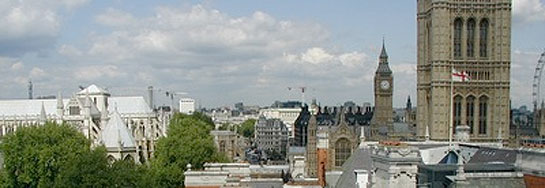Gallery
ITN Westminster Camera

The use of remotely controlled cameras is now commonplace in broadcast applications; often a live chromakey background is required behind a presenter or a well placed camera in a key position can be used for weather or general views in breaking news stories.
One of ITNs longest standing and most used fixed-site locations is their camera atop No. 1 Millbank, giving stunning panoramic views over London, the Thames and, more specifically, Big Ben and the Houses of Parliament.
 Technology and audience expectations have moved on considerably since it's original installation so a recent challenge for ITN was to bring the camera and remote telemetry into the modern age but without being able to renew the well-buried existing cable run linking the head end to the ITN control position at No. 4 Millbank.
Technology and audience expectations have moved on considerably since it's original installation so a recent challenge for ITN was to bring the camera and remote telemetry into the modern age but without being able to renew the well-buried existing cable run linking the head end to the ITN control position at No. 4 Millbank.
Rotronics Systems were brought in at an early stage to look at the problems and come up with solutions that could be carried out during the Parliamentary recess. “Our initial task was to find out exactly what the two rather elderly existing coax cables were capable of” comments Rotronics M.D. Bob Head.
The returned pulse method used by Bob and his team calculates distance by precise timing of a signal sent and received down the cable. This established a cable length of 260 meters. “Our brief from Martin Swain, Project Engineer at ITN, was to try to get SDI down the old PSF 1/2 primary coax; sending 270 MB test signals immediately produced not unexpected evidence of failed bits, the sparklies on the screen clearly showing the poor condition of the cable, so we had to come up with a more sophisticated solution. I realised that it should be possible to frequency multiplex the analogue component output and get a stable digital signal out at the other end, even through the ageing coax.”
Tests were carried out using a triax adaptor from Cytech that had originally been developed as an on-camera back. “The Cytech freestanding prototype had composite, component and digital component outputs which was more than enough to meet the ITN requirement. As well as driving triax, the signals could also be sent down up to 500 meters of coax. What was useful, indeed essential, was that the return path capability meant both D.C. powering and a reference signal could be sent back down the same coax to the camera”.
Having successfully tested and installed the internal electronics it was then necessary to put up the external camera equipment. A rugged Panasonic AW-E600 camera head was chosen for its compact size, 850 line resolution and low light sensitivity. A Canon H15a x 6 lens capable of zoom, iris and focus remoting made both wide angle and long lens shots possible.
 The weatherproof housing complete with sunshade, heater and wash/wipe facility was now ready to be put in place high on the London skyline. “Technically the cable problem was the biggest headache” recalls Bob “ but the exterior installation was certainly the most dangerous! Luckily, safety harness fixings were available but the location was such that the rigger's ladder had to be removed while he was actually fitting the camera housing ”.
The weatherproof housing complete with sunshade, heater and wash/wipe facility was now ready to be put in place high on the London skyline. “Technically the cable problem was the biggest headache” recalls Bob “ but the exterior installation was certainly the most dangerous! Luckily, safety harness fixings were available but the location was such that the rigger's ladder had to be removed while he was actually fitting the camera housing ”.
The Rotronics team had developed control and telemetry cards for the pan/tilt and remote control of the 3 lens functions, wash/wipe and remote fault diagnosis for the camera head. “Because of the exposed location of the camera we had to use high torque motors, capable of moving 15 Kg loads, to enable subtle on-air camera movement, even in the highest winds; that meant designing a special PWM card”.
Problems solved and all the remotes and triax head end are now up and running at 4 Millbank, with a single operator controlling lens functions and using a single pressure sensitive joystick for pan/tilt.
In use day and night by a number of broadcasters and available in any weather this key remote camera has finally been brought into the digital age. “There's rarely a simple job in our business”, comments Bob on completion. “There are often constrictions in any brief; sometimes it's financial, sometimes logistical, this time it was using existing cable runs. We enjoyed the challenges of this job although I'm still glad it wasn't me actually installing the camera high above London.”